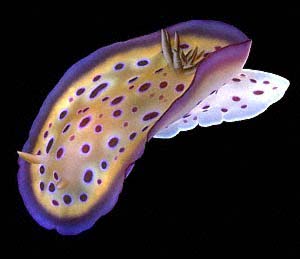
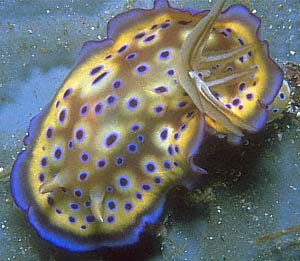
Chromodoris kuniei
Pruvot-Fol, 1930
Order: NUDIBRANCHIA
Suborder: DORIDINA
Family: Chromodorididae
DISTRIBUTION
Tropical West Pacific.
PHOTO
UPPER: Showing the characteristic mantle waving behaviour of this species, in which all the mantle edge is raised and lowered together. Noumea, New Caledonia, October 1988, 45mm long alive. PHOTO: Bill Rudman.
LOWER: Wistari Channel, Heron Is., Queensland, Australia, 20m, December 1980. PHOTO: G.Avern.
This is one of a group of similarly coloured species which I have called the "Risbecia tryoni colour group". Other species include Risbecia tryoni, Chromodoris geminus and Chromodoris leopardus. They all have large purple or purple-brown spots or marks, usually ringed with white, an often reticulate brownish background, and a purple border. Chromodoris geminus differs in having four colour bands around the mantle edge, an outermost white, then translucent greyish purple, then white, then yellow. The other three have a distinct purple line at the border, narrow in C. leopardus and R. tryoni, but broad in C. kuniei. The shape of the body of R. tryoni, high with a reduced mantle overlap, is typical of the genus Risbecia. The three species of Chromodoris have a wide mantle overlap. Of the three with the purple mantle edge, C. leopardus and C. kuniei can be distinguished from R. tryoni by the broad purple border, consisting of three slightly different coloured bands in C. kuniei, and by the leopard-like multiple spots, or marks, forming a hollow square, found in C. leopardus.
See also Chromodoris tritos.
References:
• Rudman, W.B. (1984) The Chromodorididae (Opisthobranchia: Mollusca) of the Indo-West Pacific: a review of the genera. Zoological Journal of the Linnean Society 81: 115-273.
• Rudman, W.B. (1987) The Chromodorididae (Opisthobranchia: Mollusca) of the Indo-West Pacific: Chromodoris epicuria, C. aureopurpurea, C. annulata, C. coi and Risbecia tryoni colour groups. Zoological Journal of the Linnean Society 90: 305-407.
Rudman, W.B., 1999 (January 22) Chromodoris kuniei Pruvot-Fol, 1930. [In] Sea Slug Forum. Australian Museum, Sydney. Available from http://www.seaslugforum.net/find/chrokuni
Related messages
Chromodoris kuniei with mantle abnormality
October 16, 2008
From: Marcel Tanke
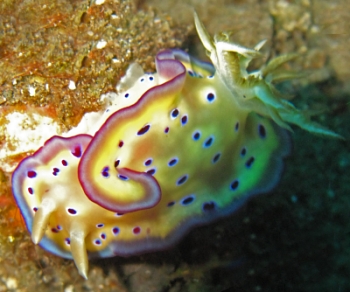
Concerning message #9996:
Dear Bill,
Attached a couple of pictures of Chromodoris kuniei with a partly spiral shaped mantle. Something for the abnormalities page?
Locality: Bali, Tulamben, dive site Drop Off, 20 m, Indonesia, 28 September 2008, Reef on vulcanic rock. Length: 4 cm. Photographer: Marcel Tanke.
Best regards,
Marcel
marceltanke@cs.com
Tanke, M.A., 2008 (Oct 16) Chromodoris kuniei with mantle abnormality. [Message in] Sea Slug Forum. Australian Museum, Sydney. Available from http://www.seaslugforum.net/find/21961
Thanks Marcel,
Best wishes,
Bill Rudman
Chromodoris kuniei -extra capsular yolk
May 1, 2006
From: James Lyle


Dear Dr. Rudman:
This Chromodoris kuinei was laying eggs at night, under a coral head; the image has been turned upright.
The animal is shaping the egg ribbon with the tip of its foot. The spiral is being deposited from the inside out, in a counter-clockwise fashion as viewed from above.
Locality: House Reef, Wakatobi Resort, 10 meters, Indonesia, Banda Sea, 16 October 2005, Coral wall. Length: 20 mm. Photographer: Jim Lyle.
Best,
Jim
jlyle@adelphia.net
Lyle, J.L., 2006 (May 1) Chromodoris kuniei -extra capsular yolk. [Message in] Sea Slug Forum. Australian Museum, Sydney. Available from http://www.seaslugforum.net/find/16465
Dear Jim,
Thanks for this interesting photo. I had suspected this animal has extra capsular yolk for some time but although photos seem to show it I didn't want to be guilty of wishful thinking, but your photos show identical dark orange-yellow blotches just like in photos of C. coi [see messages #7229, #14013]. The other thing is the purple colour on the underside of the coral head. I can't see any detail but the colour looks right for this species sponge food Chelonaplysilla violacea. If you by chnace have a photo showing any detail in the purple layer I would be interested.. It could of course be some other 'organic' layer or even purple pigment in the coral colony, but the coincidence is quite stromg and sponge-feeding nudibranchs don't normally lay their eggs on living coral colonies - even the underside.
Best wishes,
Bill Rudman
Chromodoris kuniei 'colorful' mating
March 16, 2006
From: R. Grooters and M. Snoek

Hello Bill,
We didn't find any mating pictures of Chromodoris kuniei on the Forum and since we found this two 'colors' mating, we thought it might be of interest. What colors will the offspring has?
Locality: Nudi retrait, Lembeh Strait, 24 m, Manado, Indonesia, Malukku Sea, 6 June 2004, coral on mud. Length: 4 cm. Photographer: Mieke Snoek.
Reindert Grooters and Mieke Snoek
mieke.reindert@chello.nl
Grooters, R. & Snoek, A., 2006 (Mar 16) Chromodoris kuniei 'colorful' mating. [Message in] Sea Slug Forum. Australian Museum, Sydney. Available from http://www.seaslugforum.net/find/16116
Dear Reindert & Mieke,
It's nice to see the extremes of the colour variation in this species mating. The size of the spots seem to be the main area of variability in this species. There are one other set of mating photos on the Forum, of this species, in a message from Mary Jane Adams [#5811]. Remarkably the pair could be the same as yours, one with large spots, one with small.
Best wishes,
Bill Rudman
Chromodoris kuniei from Tulamben, Bali
December 12, 2005
From: Erwin Kodiat
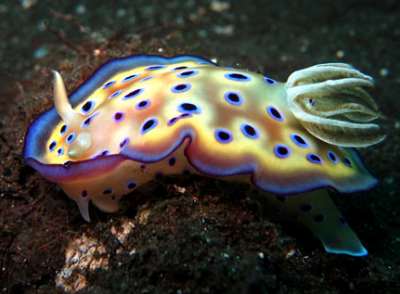
Hi Bill,
I got this in Bali. Just want to share the photo.
Locality: Tulamben, Drop Off, Bali, Indonesia. Lombok Strait. Depth: 16 meters. Length: 5 cm. 15 November 2005. Sandy. Photographer: Erwin Kodiat
Erwin Kodiat
ungu@terong.com
Kodiat, E., 2005 (Dec 12) Chromodoris kuniei from Tulamben, Bali. [Message in] Sea Slug Forum. Australian Museum, Sydney. Available from http://www.seaslugforum.net/find/15442Thanks Erwin,
Your photo shows the mantle just beginning - or ending - the rhythmic raising and lowering of the mantle edge, that occurs in this animal as it is crawling along
Best wishes,
Bill Rudman
Chromodoris kuniei from Malaysia
December 12, 2005
From: Asther Lau

Hello Bill!
Here is one Chromodoris kuniei found on Pinang Is. off Aur Is. as well.
Locality: Pinang Island, off Aur Island, Johor, Malaysia. South China Sea. Depth: 15 metres. Length: 5 cm. 2nd Sept 2004. Coral reef and boulders of rocks. Photographer: Francis Tan
Merry Christmas to you and Sea Slug Forum team!|
Asther M. Lau
asther@astherlau.com
Lau, A, 2005 (Dec 12) Chromodoris kuniei from Malaysia. [Message in] Sea Slug Forum. Australian Museum, Sydney. Available from http://www.seaslugforum.net/find/15452
Thanks Asther,
This year has gone very quickly!
Best wishes,
Bill Rudman
Chromodoris kuniei from the Coral Sea
October 1, 2005
From: Marc Saunders
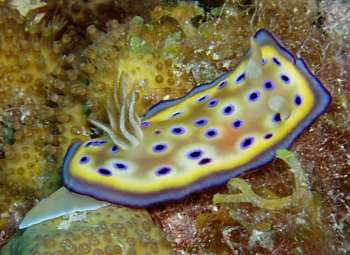
Dear Dr. Rudman,
I'd like to take the opportunity to thank you for making the Sea Slug Forum possible. When I first got into diving, I thought it would be the deep dives and wrecks that would lure me into the 10C waters during Melbourne's winter. I would never have guessed that dive objectives and plans now revolve around 15 mm slugs. This photo is from an absolute pearler of a dive on Big Dipper, an extended system of reef and bommies on the outer Great Barrier Reef straight out from Townsville.
Locality: Big Dipper, outer Great Barrier Reef , east of Townsville, Queensland, Australia. Coral Sea. Depth: 12 m. Length: 1.5 cm. 20 April 2005. Photographer: Marc Saunders.
Cannot find this in any of my resources. Would certainly appreciate your help
Marc Saunders.
marc@irm.net.au
Saunders, M., 2005 (Oct 1) Chromodoris kuniei from the Coral Sea. [Message in] Sea Slug Forum. Australian Museum, Sydney. Available from http://www.seaslugforum.net/find/14858Dear Marc,
This is Chromodoris kuniei. As you may have noticed it is one of a group of species which flap their mantle in a very characteristic way, usually with the whole of the mantle edge rising and falling together. In your photo it looks like it is just starting the upstroke.
Best wishes,
Bill Rudman
Chromodoris kuniei with trifid rhinophore
August 15, 2005
From: Rick Coleman


I was encouraged to send these pictures by Joao Pedro Silva. This Chromodoris kuniei (I believe) has an unusual attribute in that it has extra rhinospores on one side...
Locality: Kadavu Is., Fiji, Depth: 40 feet. Length: 1 inch. 21 July 2005. Photographer: Rick Coleman
Rick Coleman
RickJColeman@aol.com
Coleman, R., 2005 (Aug 15) Chromodoris kuniei with trifid rhinophore. [Message in] Sea Slug Forum. Australian Museum, Sydney. Available from http://www.seaslugforum.net/find/14557Dear Rick,
Thanks for this. We are accumulating a list of developmental oddities like this on the Forum. It may prove useful to some researcher in the future. Such dvelopmental mistakes are not that common, but with so many pairs of eyes now looking, we are building up a respectable list.
Best wishes,
Bill Rudman
Re: Chromodoris kuniei from the Marshall Islands
July 26, 2005
From: Christian Leduc
I share your feeling about "flux" [message #1194], a promising point of view.
To support my opinion:
I have observed many Cypraeidae, during three years, in diving at low tide in a Bay (Crab Bay), Malekula Is, eastern shore, Vanuatu. I have observed this "flux" for, inter-alia: Palmadusta humphresii, P. lutea, P. asellus and P. clandestina. I believe that the flux liaises also with the reproduction cycle under some respects (period of a given year). Yes, Chromodoris kuniei isn't a Cypraeidae but this might support the conceptual meaning.
J Christian Leduc
Agriculturalist
Cypraea enthusiast
norsup@usa.net
Leduc, J.C., 2005 (Jul 26) Re: Chromodoris kuniei from the Marshall Islands. [Message in] Sea Slug Forum. Australian Museum, Sydney. Available from http://www.seaslugforum.net/find/14417Dear Christian,
It took me a while to find the discussion you were referring to. I am glad we have had plenty of other matters to discuss in the intervening 6 years - though it is an excellent example of how nothing actually goes 'out of date' on the Forum.
Best wishes,
Bill Rudman
Chromodoris kuniei raising its mantle skirt
July 11, 2004
From: Choi, Sungsoon

Hi Dr. Bill Rudman.
I am underwater photographer and magazine editor of Scuba Diver Magazine in Korea.
Recently I received some images of seaslug, I hope to introduce our readers.
But I can not identify two of them.
The two images taken at Puerto Galera, Philippines.
Best regards,
Choi, Sungsoon
diver@scuba-diver.net
Sungsoon, C., 2004 (Jul 11) Chromodoris kuniei raising its mantle skirt. [Message in] Sea Slug Forum. Australian Museum, Sydney. Available from http://www.seaslugforum.net/find/12678Dear Choi,
This is Chromodoris kuniei . Your photo shows its characteristic behaviour of raising and lowering its mantle skirt as it crawls along.
Best wishes
Bill Rudman
Chromodoris kuniei from Fiji
June 21, 2003
From: Leanne & David Atkinson
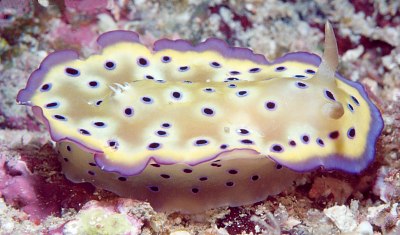
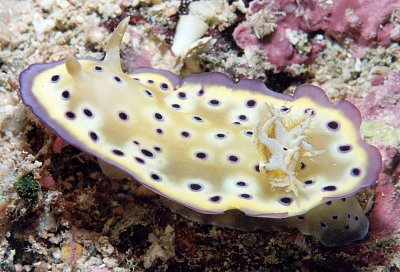
Dear Bill,
Here is another photo of Chromodoris kuniei, this time without the satellite dish. You didn't have any from Fiji on the Forum, so we thought we'd send this one to extend the range. It was moving very rapidly when we saw it, waving its mantle. David videoed it while I took stills.
We have visited the same area 3 times over 3 consecutive years and this is the only Chromodoris kuniei that we have seen. We couldn't say they were common in the area.
The photo details are:
Location: Plantation Pinnacle, near Malolo Lai Lai Island, Fiji.
Date: 23.04.02 Time:10:00am
Depth: 20m Water Temp: 30 degrees c.
Regards,
Leanne & David Atkinson
atk@hunterlink.net.au
Atkinson, L. & D., 2003 (Jun 21) Chromodoris kuniei from Fiji. [Message in] Sea Slug Forum. Australian Museum, Sydney. Available from http://www.seaslugforum.net/find/10175Thanks Leanne & David,
Bill Rudman
Re: Another Chromodoris kuniei with deformity
June 4, 2003
From: Roberto Sozzani
Dear Bill,
You're right, it's the same animal. Lisa and I were on the same cruise and dove the same places.
Best regards
Roberto Sozzani
roberto.sozzani@fastwebnet.it
Thanks Roberto,
Bill Rudman
Re: What's up with this Chromodoris kuniei?
June 4, 2003
From: Peter H. van Bragt
Hello Lisa and Bill,
Just looking at the picture, I guess that the growth abnormality is a second mantle developing. The re-occurring coloration of the mantle's edge seems quite typical. Most likely there has been a malfunction at the level of signal transduction during the embryonic or larval development of this specimen. I assume that we know very little about the growth factors, chemical messengers and related recopters responsible for tissue (organ) differentation during embryonic development in seaslugs, but a large variety of similar growth development abnormalities are of course known from all sorts of other representatives of the animal kingdom.
A second guess could be that due to some injury during larval development and as a result of the healing process this growth abnormality developed. But then again it would be the result of misfiring growth factors and their receptors.
Which argument is most valid??? We will never know.
Peter
vanbragt.phjm@hsbrabant.nl
Dear Peter,
I really didn't think the Abnormalities Page would result in so many contributions. In most cases the abnormalities seem to be the result of some dvelopmental abnormality, as you suggest. Very few seem to be the result of injury repair in the metamorphosed slug. In Roberto's photos of the same slug it seems the damage also affected the development of the rhinophores as well
Best wishes
Bill Rudman
Another Chromodoris kuniei with deformity
June 3, 2003
From: Roberto Sozzani


Dear Bill,
Here is a Chromodoris kuniei with evident deformity, from the island of Alor, north of Timor, on a small wall with sand and corals.
The left rhinophore, underwater, appeared flat and round, like if a juvenile was sitting between rhinophores. Only from the slide I could see details and deformities of both rhinophores.
Date: February 2003
Depth: 14m.
Size: 4cm.
I hope this can be interesting for your Forum.
Best regards
Roberto Sozzani
roberto.sozzani@fastwebnet.it
Sozzani, R., 2003 (Jun 3) Another Chromodoris kuniei with deformity. [Message in] Sea Slug Forum. Australian Museum, Sydney. Available from http://www.seaslugforum.net/find/9918Dear Roberto,
I'm posting this with Lisa Malachowsky's message which is also about a Chromodoris kuniei from the Timor region with a very similar deformity. Actually looking at the spots in Lisa's photo I wouldn't be surprised if they are the same animal - which would be rather a coincidence. I can't see the right rhinophore in her photo so can't see if that is also bifid. Another interesting record for the Abnormalities Page
Best wishes,
Bill Rudman
What's up with this Chromodoris kuniei?
June 3, 2003
From: Lisa Malachowsky
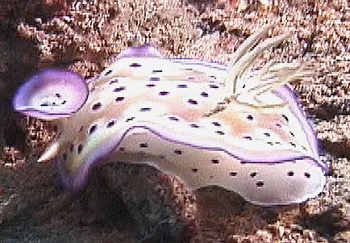
Here is a picture taken in Timor in February 2003. It is a captured frame from the video I took while on a cruise with Kararu. This Chromodoris kuniei (I think) seems to have a 'satellite dish' between its rhinophores. It's another oddity from the trip that my partner Sharron and I took this year.
Lisa Malachowsky
grrldive@pacbell.net
Malachowsky, L., 2003 (Jun 3) What's up with this Chromodoris kuniei?. [Message in] Sea Slug Forum. Australian Museum, Sydney. Available from http://www.seaslugforum.net/find/9996Thanks Lisa,
Certainly a strange abnormality. Looks a bit like a satellite dish - I know some sea slugs are solar powered but receiving electronic signals would be a bit much even for them.
Best wishes,
Bill Rudman
Chromodoris kuniei from Indonesia
November 25, 2002
From: Ginette Allard

Is this Risbecia tryoni or perhaps Chromodoris kuniei. I took this photo in south Sulawesi (Hoga) 3 years ago. I met the same in Manado in April 2002.
Thank you for your help,
Ginette Allard
gigiallard@aol.com
Allard, G., 2002 (Nov 25) Chromodoris kuniei from Indonesia. [Message in] Sea Slug Forum. Australian Museum, Sydney. Available from http://www.seaslugforum.net/find/8464Dear Ginette,
This is Chromodoris kuniei.
Bill Rudman
Chromodoris kuniei from Malaysia
July 13, 2002
From: Richard Houghton

Bill,
Here is another nudibranch found off Pulau Aur, Malaysia in May 2002.
Happy diving,
Rich
richard_houghton@hotmail.com
Houghton, R., 2002 (Jul 13) Chromodoris kuniei from Malaysia. [Message in] Sea Slug Forum. Australian Museum, Sydney. Available from http://www.seaslugforum.net/find/7501Thanks Rich,
This is Chromodoris kuniei.
Cheers,
Bill Rudman
Chromodoris kuniei from Christmas Island
April 26, 2002
From: Bill Rudman

This is the first of a series of messages I am posting on a collection of opisthobranchs made by John Hicks at Christmas Island, Indian Ocean in the 1980s. For background information have a look at the Christmas Island collections page.
PHOTO: AM C132439, 38 mm long alive. 8 November 1981, off Bruce Beach, on top of coral, 25 m, Christmas Island, Indian Ocean. Photo: John Hicks
This record of Chromodoris kuniei illustrates the interesting nature of the material, which suggests that Christmas Island can be considered to straddle both the Indian and West Pacific ocean faunas. C. kuniei is essentially a western Pacific species, being replaced in the Indian Ocean by C. geminus and perhaps C. tritos.
Best wishes,
Bill Rudman
Chromodoris kuniei from Malaysia
April 19, 2002
From: Kheong Sann Chan

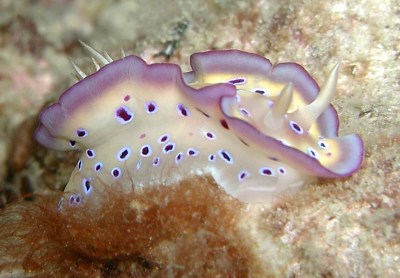
Hi Dr. Rudman,
Here are photos of another nudibranch from
Pulau Dayang off the East Coast of Malaysia, on April 4, 2002. Depth varied approximately 15-23m deep.
Kheong.
kschan@mail.dsi.nus.edu.sg
Sann Chan, K., 2002 (Apr 19) Chromodoris kuniei from Malaysia. [Message in] Sea Slug Forum. Australian Museum, Sydney. Available from http://www.seaslugforum.net/find/6758Dear Kheong,
This is Chromodoris kuniei. Apart from its beautiful colour, it has the spectacular habit of lifting the edge of its mantle skirt up and down, as you have captured so well in your photo. Another species with the same behaviour is Chromodoris coi.
Best wishes,
Bill Rudman
Chromodoris kuniei - juvenile from Bali
February 20, 2002
From: Stuart Hutchison

Bill,
Here's a juvenile Chromodoris kuniei from Bali, Indonesia on 17 Oct 2001. Found on the move at 20m on a wreck. It's the only juvenile C. kuniei we've seen so far.
Stuart.
stuart@stuarthutchison.com.au
Hutchison, S., 2002 (Feb 20) Chromodoris kuniei - juvenile from Bali. [Message in] Sea Slug Forum. Australian Museum, Sydney. Available from http://www.seaslugforum.net/find/6258Thanks Stuart,
Bill Rudman
Chromodoris kuniei laying eggs
December 15, 2001
From: Mary Jane Adams

Hi Bill,
Following on from yesterday's message about Chromodoris kuniei and its behavior in Papua New Guinea, a couple of weeks later I observed another Chromodoris kuniei laying eggs at 15 meters at "White Beach," in the Russell group of the Solomon Islands. This slug had chosen to deposit its eggs on a finger of dead coral with a lot of algae growing on it. It took a couple of hours to complete the irregular egg coil. At times it was hanging upside down as it circled the coral.
Best regards,
Mary Jane
divepng@yahoo.com
Adams, M.J., 2001 (Dec 15) Chromodoris kuniei laying eggs. [Message in] Sea Slug Forum. Australian Museum, Sydney. Available from http://www.seaslugforum.net/find/5814Thanks Mary Jane,
Bill Rudman
Chromodoris kuniei - 'courtship dance'
December 13, 2001
From: Mary Jane Adams

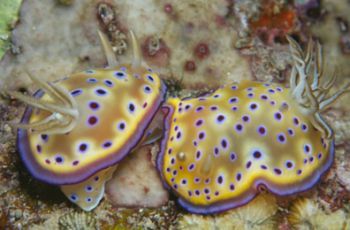
Hi Bill,
I observed Chromodoris kuniei in an interesting behavior recently. While diving on "Lillian's Patch" reef in Bootless Bay, Papua New Guinea, October 2001] I came across three of them at about 15 meters. When I started photographing the closest one, the second was sitting under an overhang about half a meter a way and the third one was sitting in the middle of a sponge patch about a meter further on. Then the second one started crawling directly toward the first one. When it was within about ten cm., the first one seemed to "wake up" and started waving its mantle up and down. They first made contact head-to-head [upper photo]. The second slug paused for about half a minute, then started moving again. It made a wide circle around the first one before aligning itself in the mating position [lower photo]. The third slug remained stationary throughout this activity.
Best regards,
Mary Jane
divepng@yahoo.com
Adams. M.J., 2001 (Dec 13) Chromodoris kuniei - 'courtship dance'. [Message in] Sea Slug Forum. Australian Museum, Sydney. Available from http://www.seaslugforum.net/find/5811Thanks Mary Jane,
The only related animals which seem to have what could be called a ritualised courtship behaviour are some land snails such as the European Helix aspersa which is now a garden pest worldwide. If land snails can have ritualised mating dances there is no reason why opisthobranchs can't. We just need some dedicated animal behaviourists to start looking.
PS: Before anyone reminds me recent taxonomic studies can't really be ignored. I fear we should be calling Helix aspersa by the name Cantareus aspersus.
Cheers,
Bill Rudman
Chromodoris kuniei & sponges
November 27, 2001
From: Lindsay Warren

Dear Bill
Seeing messages about Chromodoris kuniei and sponges I thought you might find the following photos of interest. Although C. kuniei has been found on various surfaces in the Tukang Besi Archipelago, SE Sulawesi, Indonesia, I have one photo of a specimen on a sponge. However, as you can see from the attached a photo, it is a very different sponge to those featured so far on the Sea Slug Forum for C. kuniei. This specimen (OS0881) was feeding very dedicatedly on this burgundy sponge which although firm to the touch is was also quite elastic, springing readily back to shape. C. kuniei L: 37 mm. Depth: 12.7 m. Just 20 cms below this specimen was another one (OS0882 - LOWER RIGHT) laying an egg mass on dead coral covered in algae at the base of a partially dead Tubastraea micrantha, L: 43 mm. I found them on 4 November 1999 at 15.30pm on an exposed reef wall which is subjected to very strong currents particularly at rising and falling tides.
All the best
Lindsay Warren
alldcl@compuserve.com


Thanks Lindsay,
This sponge certainly looks like the sponge a chromodorid would feed on. It has the look of Aplysilla, Darwinella or Dysidea, three genera commonly eaten by this family.
Best wishes,
Bill Rudman
Re: Chromodoris kuniei from Tufi, PNG
November 23, 2001
From: Des Paroz
Regarding your question about the specimen on the orange sponge - it was found regularly throughout the week in the same general area, and always on this sponge or a similar orange one. I have various photos taken over the week to support this.
Best regards
Des
des@paroz.com
Paroz, D., 2001 (Nov 23) Re: Chromodoris kuniei from Tufi, PNG. [Message in] Sea Slug Forum. Australian Museum, Sydney. Available from http://www.seaslugforum.net/find/5545Thanks Des,
It would be interesting to know if others have photographed it a similar looking sponge
Bill Rudman
Chromodoris kuniei from Tufi, PNG
October 22, 2001
From: Des Paroz

Dear Bill
Another elegant nudibranch that was found in "The Muck" area around Tufi Wharf, Papua New Guinea, September 2001.
Photos are of 2 specimens, found within a few metres of each other. Both were spotted consistently over a week long period of diving this site every day.
Water temp 28C and little water movement.
Best regards
Des
des@paroz.com


Thanks Des,
It would be interesting to know if the animal on the orange sponge stayed there during the week or was just passing by when you photographed it. My interest, as usual, is whether this sponge is a possible food source for this species.
Cheers,
Bill
Chromodoris kuniei with one rhinophore
June 12, 2001
From: Stuart Hutchison
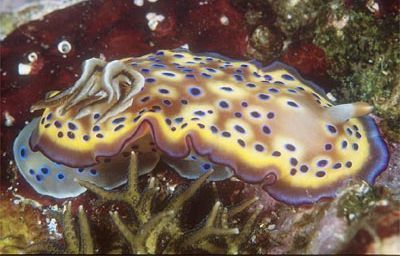
Bill,
Here's a Chromodoris kuniei with only one rhinophore. I had a very good look at the body and there was not a mark where a rhinophore may have been - I can only assume it developed without the second. You may be able to detect what looks like wrinkles just rearward of the rhinophore in my scan, but the wrinkles were symetrical and extended right over the other side.
The specimen was found at Batu Kelebit near Tulumben - Indonesia in 45m water and was about 60mm long.
Regards,
Stuart
hutchco@tpg.com.au
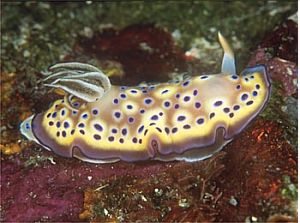

Thanks Stuart,
It's hard to know with some of these abnormalities whether they are a result of accidental or predator damage or whether they have been caused by a developmental problem. Although there has been little formal research on the subject, opisthobranchs do seem able to regrow parts of their body quite quickly after damage, but whether all parts can regenerate to the same extent I wouldn't know.
Best wishes,
Bill Rudman
Tonga Records: Chromodoris kuniei
May 29, 2001
From: Don Barclay
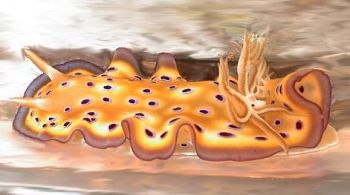
Hi Bill,
Here's the last of the decent photos I took of slugs in Tonga. Like several of the ones already submitted, this nudibranch, Chromodoris kuniei, was found crawling on rubble in ~10 meters of water across the channel from the Tongan Beach Resort, Utungake Island, Vava'u, Tonga, after noon on 16 February 2001. This slug measured around 60mm. This was the end of my photography there, because: 1) 240/120 volt AC adapters like the one I had don't work well with cheap battery chargers, they will explode them instead... 2) Unless your camera takes C-cells, you won't find batteries for it in Vava'u.
Tofa soifua,
Don
n5ols@samoatelco.com
Barclay, D., 2001 (May 29) Tonga Records: Chromodoris kuniei. [Message in] Sea Slug Forum. Australian Museum, Sydney. Available from http://www.seaslugforum.net/find/4408Thanks Don,
Your battery woes make the photos you took even more valuable
Cheers,
Bill Rudman
Chromodoris kuniei with three rhinophores
March 13, 2001
From: Mary Jane Adams

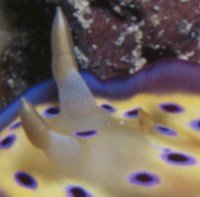
Hi Bill,
While looking through my files I noticed that this Chromodoris kuniei seems to have a rudimentary third rhinophore. Sunlight Passage, Russell Island group, Solomon Islands. November, 1999.
Best regards,
Mary Jane
divepng@yahoo.com
Adams, M.J., 2001 (Mar 13) Chromodoris kuniei with three rhinophores. [Message in] Sea Slug Forum. Australian Museum, Sydney. Available from http://www.seaslugforum.net/find/3970Thanks Mary Jane,
Not quite as spectacular as Jeanette Johnson's photo of Glossodoris hikuerensis, but definitely another one to add to the Abnormalities Page.
Best wishes,
Bill Rudman
Re: Mantle flapping in 'Glossodoris ransoni'
July 27, 2000
From: Mary Jane Adams
Dear Bill,
Hold the presses! I am attaching a message from Cat Holloway, another member of the Phoenix Islands Expedition team. She took video of "Glossodoris ransoni" so her report on how it lifts it's mantle is more reliable than mine. Please disregard my comments about mantle movement. It appears that you are 100% correct in your belief that this slug is a color form of C. kuniei.
Regards,
Mary Jane
=======
Note from Cat Holloway:
Loved the slug update...
Our video shows certainly that your slug lifts it's skirt all at once! Maybe not totally perfectly simultaneously every single time, but clearly the aim is to get it up in one strong movement. On occasion it slightly undulates but mostly it lifts its mantle in dramatic breathtaking kind of whooosh
motion. Ah, its a whole other world down there...
Slug forums eh? My mother never warned me about this!
Cat.
========
Mary Jane Adams
mjadams@earthlink.net
Adams, M.J., 2000 (Jul 27) Re: Mantle flapping in 'Glossodoris ransoni'. [Message in] Sea Slug Forum. Australian Museum, Sydney. Available from http://www.seaslugforum.net/find/2779Dear Mary Jane,
I'm afraid the presses had already rolled! I posted your message last night. Thanks very much for Cat's message. I think it pretty much confirms your animal's relationship to C. kuniei.
Please pass on my thanks to Cat, and thanks to you for following up my query so successfully.
Best wishes,
Bill.
Re: 'Glossodoris ransoni' from Phoenix Ids
July 26, 2000
From: Mary Jane Adams
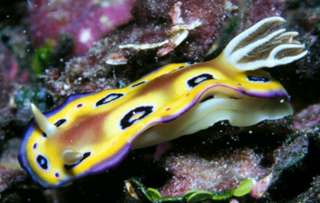
Dear Bill,
Thanks so much for the information about the slugs I found in the Phoenix Islands. I took 13 shots of the chromodorid crawling over Halimeda. In most of them the mantle is down. It did not seem to lift it's mantle all at once like C. kuniei, but rather in sections or waves. There are no spots on the foot in any of my shots, however this image shows some dark spots on the underside of the mantle.
Best regards,
Mary Jane
mjadams@earthlink.net
Adams, M.J., 2000 (Jul 26) Re: 'Glossodoris ransoni' from Phoenix Ids. [Message in] Sea Slug Forum. Australian Museum, Sydney. Available from http://www.seaslugforum.net/find/2770Dear Mary Jane,
Thanks for this photo. It certainly shows at least some spots on the foot, if not quite as numerous as in 'typical' C. kuniei.
Concerning the way it waves its mantle. It would have been nice if you had seen it waving the edge of the mantle up simultaneously and then down again, like in 'typical' C. kuniei, but NOT seeing it is unfortunately not conclusive either way. Although C. kuniei does have its spectacular simultaneous wave of the mantle edge, it can also do the much more normal 'ripple' or longitudinal wave down the mantle as you observed in your specimen.
If by chance one of your slides shows the underside of the head end of the mantle it would be nice to see, because in C. leopardus the underside of the anterior mantle is deep purple, while in C. kuniei it is translucent white except at the edge.
Best wishes,
Bill Rudman.
'Glossodoris ransoni' from Phoenix Ids
July 23, 2000
From: Mary Jane Adams
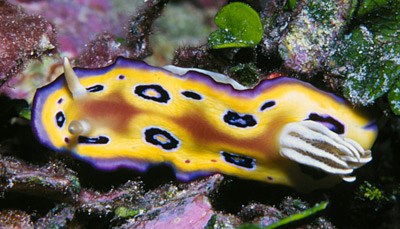

Hi Bill,
The New England Aquarium-Nai'a expedition to the Phoenix Islands was a huge success. I was thrilled to be in the first group of scuba divers to visit these remote, uninhabited islands.
[The Phoenix Ids are in the central Pacific, approx 1000k north of Samoa]
The reefs are covered with hard corals down to 30 meters with some gorgonian fans and wire corals below this depth. The coral is in pristine condition with very little bleaching. We saw a wide variety of reef fish, schooling fish, numerous reef sharks, rays and turtles. The invertebrate life was less prolific. I only saw four slugs in 40 dives. These included one Elysia ornata and one aeolid, each about 1 cm long; one chromodorid and one phyllidid. The chromodorid looks like a typical Chromodoris leopardus. I found it crawling over rubble and Halimeda at 25 meters on the lee side of Nikumaroro (Gardner) Island on June 6, 2000. It was 48 mm long. It appears to have a bite out of the left side of it's mantle (upper photo) and to be grazing(lower photo).
I have sent the one phyllidid as a separate message.
Thanks!
Mary Jane
mjadams@earthlink.net
Adams, M.J., 2000 (Jul 23) 'Glossodoris ransoni' from Phoenix Ids. [Message in] Sea Slug Forum. Australian Museum, Sydney. Available from http://www.seaslugforum.net/find/2761
Dear Mary Jane,
Your visit sounds very exciting and although your were a little bit low on nudibranch numbers it is definitely a case of quality rather than quantity.
Although your chromodorid looks like C. leopardus I am pretty sure it is a colour form of Chromodoris kuniei. The three shades of purple at the mantle edge are typical of that species, whereas in C. leopardus there isa single narrow purple edge. Another interesting difference is that in C. kuniei the whole of the mantle edge is raised and lowered simultaneously whereas in C. leopardus only the anterior end is 'flapped'. From your upper photo it appears all the mantle is being raised. I agree that the purple rings, rather than spots are closer to C. leopardus but in that species the markings are brown and not outlined with white as in your animal.
When I reviewed C. kuniei I considered another species, Glossodoris ransoni Pruvot-Fol, 1954, was almost certainly a colour form of C. kuniei, although like your animals it had rings rather than spots (Rudman, 1987). I have added Pruvot-Fol's sketches alomgside. It was described from a preserved animal and was from Hikuera, Tuamotu Archipelago, which like the Phoenix Ids is quite a distance east in the Pacific. I am sure your animal is the same colour form and as far as I know, the first colour photo of it. It is indeed an interesting find. One difference I can see in your photos from typical C. kuniei is a lack of spots on the foot.
Rferences:
• Pruvot-Fol, A. Etude d'une petit collection d'opisthobranches d'Oceanie francaise Journal de Conchyliologie, 94(1): 3-30.
• Rudman, W.B. (1987) The Chromodorididae (Opisthobranchia: Mollusca) of the Indo-West Pacific: Chromodoris epicuria, C. aureopurpurea, C. annulata, C. coi and Risbecia tryoni colour groups. Zoological Journal of the Linnean Society, 90: 305-407.
Best wishes,
Bill Rudman
Chromodoris kuniei from Papua New Guinea
February 5, 2000
From: Stuart Hutchison

Bill,
Here is Chromodoris kuniei - I think. It was located on a rusty old yacht hull in about 10m of water off Lion Island - Papua New Guinea (just near Loloata Island). Its colours are very hard to scan accurately because of they're luminosity, but it's close. I have photos of another C. kuniei in Milne Bay (from about 15M deep).
That's about all I can say for this one.
Regards,
Stuart Hutchison.
hutchco@tpg.com.au
Hutchison, S., 2000 (Feb 5) Chromodoris kuniei from Papua New Guinea. [Message in] Sea Slug Forum. Australian Museum, Sydney. Available from http://www.seaslugforum.net/find/1821Chromodoris kuniei from the Marshall Islands
August 16, 1999
From: Scott Johnson

Hi Bill,
The Marshall Islands should be a range extension for Chromodoris kuniei. I had never found the species here before the fall of 1989. Over the next year, I perhaps 20 specimens, all exposed on the steep western seaward slope of Kwajalein Atoll at depths of 20 meters or more. Then suddenly--no more, except one small specimen found about 3 years ago. This is an area I dive all the time, and it (along with numerous other observations) helps to drive home the idea that populations out there are truly in a constant state of flux. I suspect that chance settling events (perhaps associated with eastward moving water masses that go along with El Nino?) can greatly impact the communities we see.
Scott
johnson@kmr.ll.mit.edu
Johnson, S., 1999 (Aug 16) Chromodoris kuniei from the Marshall Islands. [Message in] Sea Slug Forum. Australian Museum, Sydney. Available from http://www.seaslugforum.net/find/1194Dear Scott,
Thanks for the record. I like your idea about the populations being in a state of flux. I was in Tanzania for five and a half years and I was still finding new records every week or so. I guess when we go somwhere with a 'species list' we tend to be disappointed if we can't find at least half of the species on it, forgetting that the list is often the accumulation of many years effort. In Sydney, which is way south of the tropics, we have an excellent intertidal collecting spot called Long Reef, which as its name suggests, juts out into the currents, sampling the larvae in the southward flowing eddies and current. If you looked at a list of the cowries collected from Long Reef you would think it was in the middle of the tropics, but most of the species on the list have only been found once or twice over many years, chance travellers from more tropical waters.
I would suspect that even in the 'lushest' tropical environments only a small proportion of the 'recorded' species will be present at any one time.
Bill Rudman.
Chromodoris kuniei from the Philippines
January 22, 1999
From: Erwin Koehler

Bill,
Here is Chromodoris kuniei (Pruvot-Fol, 1930), BBC, Panglao Is., Philippines, Nov. 1998
Erwin
E.Koehler@deutschepost.de
Koehler, E., 1999 (Jan 22) Chromodoris kuniei from the Philippines. [Message in] Sea Slug Forum. Australian Museum, Sydney. Available from http://www.seaslugforum.net/find/493